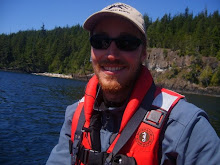
Back in January, David Shiffman of the ever insightful Southern Fried Science came out with an interesting post which begged the age-old question 'Can marine protected areas save the ocean?' Actually, the question was more like 'Can no-take areas save fish stocks?' The conclusion he reached was that yes, maybe, in some cases, if everything is done right, it would probably help. Of course, he put it much more eloquently than that and also used this wonderful cartoon, which I have shamelessly reposted (courtesy of NOAA):
Fast forward to the present (well, let's say two weeks ago), and the publication of a paper in PLoS ONE: Large Recovery of Fish Biomass in a No-Take Marine Reserve. 'A paper', you say, 'What gives?' True, I lured you in with the hot fudge sundae of marine humour only to serve you the cold goulash of peer-reviewed literature. But not to worry, I will summarize.
The study took place in Cabo Pulmo National Park, marine reserve on the south-east tip of the Baja California Sur in Mexico. The reserve includes a large 'no-take' area (or 35 % of the total area) that was closed to fishing. The park was surveyed in 1999, four years after it was established, but no significant difference was found between the biomass (the total living mass) of the fish there and and surrounding areas where fishing was permitted. However, the reserve was surveyed again ten years later and this time there was a large difference.
How large, you ask? Over those 10 years the fish biomass in the park had increased 463 %, while there was no significant change in surrounding areas. Not only that, but the biomass of top predators, such as sharks, had increased by an astounding 11 times. In fact it was the largest recovery recorded for any marine reserve in the world!
There have been many other examples of success in marine reserves around the world. California's Channel Islands National Marine Sanctuary for instance, a network of marine protected areas which includes 10 strictly no-take reserves, was shown to have produced many benefits after the first five years. The diversity of species and number of fish had increased, particularly near the center of the reserves, and another recent paper (Mmm... goulash) showed the biomass of fishes targeted by fishing had almost doubled. You can read several other success stories on the International Union for the Conservation of Nature (IUCN) webpage: Protecting the oceans makes economic sense.
But why was there such great success in Cabo Pulmo?
Of course, there are many reasons. The reserve was much larger than many areas that had been studied in the past, which allowed protection of many fish species with large home ranges. The area is very productive and its coral habitats were intact when the reserve was established. The length of time since the reserve was established likely also played a role, as a recent large-scale study of marine reserves found that it takes 13 years on average to see the full effect of protection on all species in these areas.
However, the main reason behind the success of Cabo Pulmo was local leadership and the support of the broader community. Local boat captains, dive masters and residents helped to enforce the regulations of the reserve, monitor important sites, and clean the beaches and oceans. In other words, those people who relied on this corner of the ocean for their livelihood bought into the idea of protecting it, and took on part of the responsibility for doing so themselves.
Planning for marine protection can take place at many levels, from the international commitments that countries make to protect a certain percentage of their oceans by a particular year, to discussions with local industries, governments and aboriginal groups about where and how this protection will be put in place. Cabo Pulmo shows us that the key to this protection in the long term rests with the people who work on the water and live in the local communities.

No comments:
Post a Comment